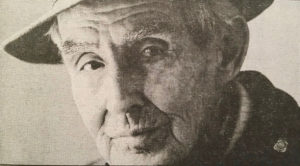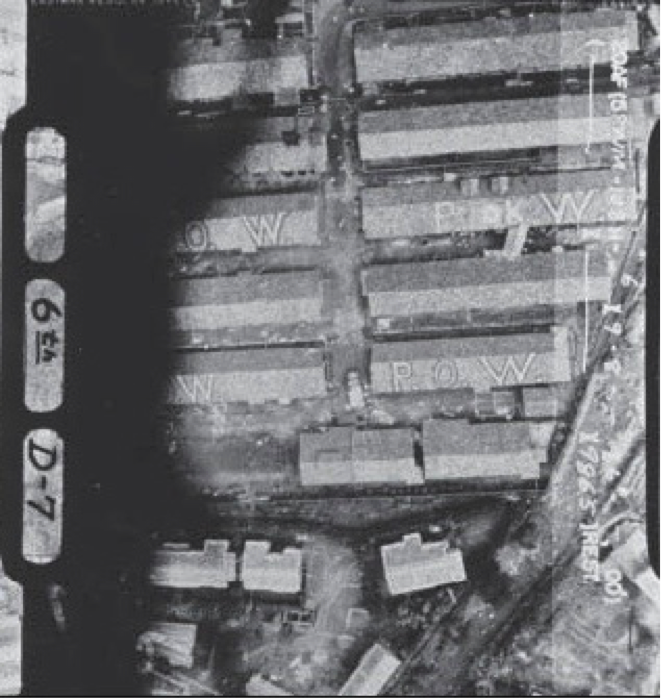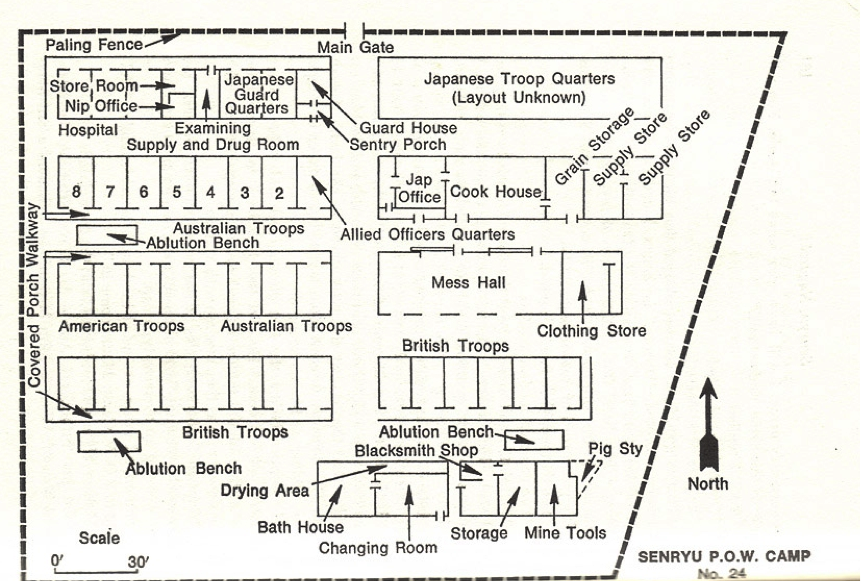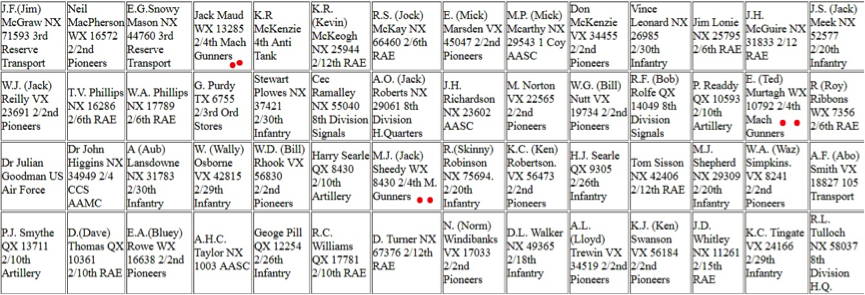Sendyu, Emukae - machi Senryu, Fukuoka #24-B - Japan
Sendyu, Emukae, Fukuoka #24-B – Japan
Fukuoka Branch Camp #24-B
(SUMITOMO KOGYO SENDRYU KOGYO-SHO)
Sumitomo Coal Company
Nagasaki-ken, Kita-Matsuura-gun, Emukae-machi, SENRYU (now part of Sasebo City)
We wish to acknowledge and thank Mansell website for access to the extensive information.
Camp was established 15 Jan 1945 as Fukuoka #24 Senryu (Emukae).
On 16 Jan 1945, 150 Australian POWS and Americans arrive on ‘Awa’ Maru from Singapore.
On about 5 Mar 1945 British POWs arrived from Taiwan (Formosa) on board ‘Taiko’ Maru.
POWs were recovered during Sep 1945.

Above: Camp drawing by MccPherson
Labor:
The POWs worked as slaves for the Sumitomo Coal Mining Company; Emukae Mine

“While the miners in the photo are Japanese the conditions for the much bigger bodied Westerners crouching for long hours in the confined space while working can be imagined. I hope that the photo, which was supplied to me by the officials of Sumitomi Mining during my visit in 2002, can be used as part of the history of World War II, it is difficult for us survivors to adequately describe the conditions under which we worked, this photo does this very well.” Neil MacPherson
Neil McPherson’s short history
15th December 1944, saw 545 Australian prisoners from River Valley Road camp, under the leadership of Flt Lt Sutherland, board the Awa Maru in Singapore. All are survivors of A Force on the Death railway. After 11 days battened down under scorching decks we sailed for Japan on Boxing Day. On 15th January 1945 the prisoners staggered ashore at Moji, Kyushu – dirty, bedraggled & starved, but unbowed, it was mid winter, snow on the ground.
150 of the group travelled to Senryu Emukae, after several days of training by Jap miners we were classified fit to work in a Sumitomo owned coalmine.
Compared to the horrors, death, disease, squalid conditions and brutal treatment on the Burma railway, conditions at camp 24 were 5 star. Comfortable warm huts, 12 men to an airy room. Apart from petty harassment by the guards, insufficient food to sustain the long shift in cramped and hazardous conditions underground, the morale was excellent. The Jap miners were helpful in teaching us how to survive in this dangerous environment, and unlike other work areas, no punishments were handed out.
On the 16th August 1945 we were told “the war is over”. We took over the camp. Supplies dropped by US bombers helped make the next 5 weeks a pleasant memory. Hikes into the countryside, invitations from farmers, sharing their scarce food, prisoners in return sharing the bounties from the US planes.
Hell Ships
Awa Maru carried the Australians & Americans from Singapore 26 Dec 1944 Taiko Maru– carried only British from Taiwan (Keelung) departing 27 Feb 1945- arrived 10 March 1945
Short History:

Contributed by WX16572 Neil O. MacPherson 2/2nd Pioneer Battalion
15th December 1944, saw 545 Australian prisoners from River Valley Road camp, under the leadership of Flt Lt Sutherland, board the Awa Maru in Singapore. All are survivors of A Force on the Death railway. After 11 days battened down under scorching decks we sailed for Japan on Boxing Day. On 15th January 1945 the prisoners staggered ashore at Moji, Kyushu – dirty, bedraggled & starved, but unbowed, it was mid winter, snow on the ground.
150 of the group travelled to Senryu Emukae, after several days of training by Jap miners we were classified fit to work in a Sumitomo owned coalmine.
Compared to the horrors, death, disease, squalid conditions and brutal treatment on the Burma railway, conditions at camp 24 were 5 star. Comfortable warm huts, 12 men to an airy room. Apart from petty harassment by the guards, insufficient food to sustain the long shift in cramped and hazardous conditions underground, the morale was excellent. The Jap miners were helpful in teaching us how to survive in this dangerous environment, and unlike other work areas, no punishments were handed out.
On the 16th August 1945 we were told “the war is over”. We took over the camp. Supplies dropped by US bombers helped make the next 5 weeks a pleasant memory. Hikes into the countryside, invitations from farmers, sharing their scarce food, prisoners in return sharing the bounties from the US planes.
WX13285 Jack Maud, WX8430 M.J. (Jack) Sheedy and WX10792 E (Ted) Murtagh were all members of the 2/4th MGB incarcerated at Sendyu.
“We were working at the 300 ft level in the mine when there was huge bang and were were thrown heavily against the walls of the shaft. The blast and after shock were so powerful that all the lights went out, dirt fell from the shaft roof and the pit props creaked, some even bending. Our first thought was that the mine had received a direct hit (from US B29 bombing raids) and we were being buried alive. In the darkness the miners crawled upward for three hours.
On reaching the surface we found a deserted mine compound – the guards had fled into the hills. It was 9th August 1945, the mine was 25 kilometres from Nagasaki.”
They had no knowledge of the atomic bomb, nor that it had annihilated the town. Their long-awaited freedom had arrived. From “Ghosts in Khaki” by Les Cody.
Jack Maude suffered from the effects of radiation all his life. He was regularly at Hollywood Hospital and in his later years could only eat food that was mashed and softened. He was never able to eat at a dining table with friends.
Referenced to and where further information can be found at http://www.mansell.com/pow_resources/camplists/fukuoka/fuk-24-sendryu/fuku_24_sendryu.html
Digger lived to tell of A-blast that flattened Nagasaki
(The Sunday Times – 14th August 1994)

Above: Jack Maude, former Fairbridge Farm School Boy – who suffered from the affects of Atomic bomb – his food mashed to feed every day – Jack suffered long term injuries to his throat and lungs.








